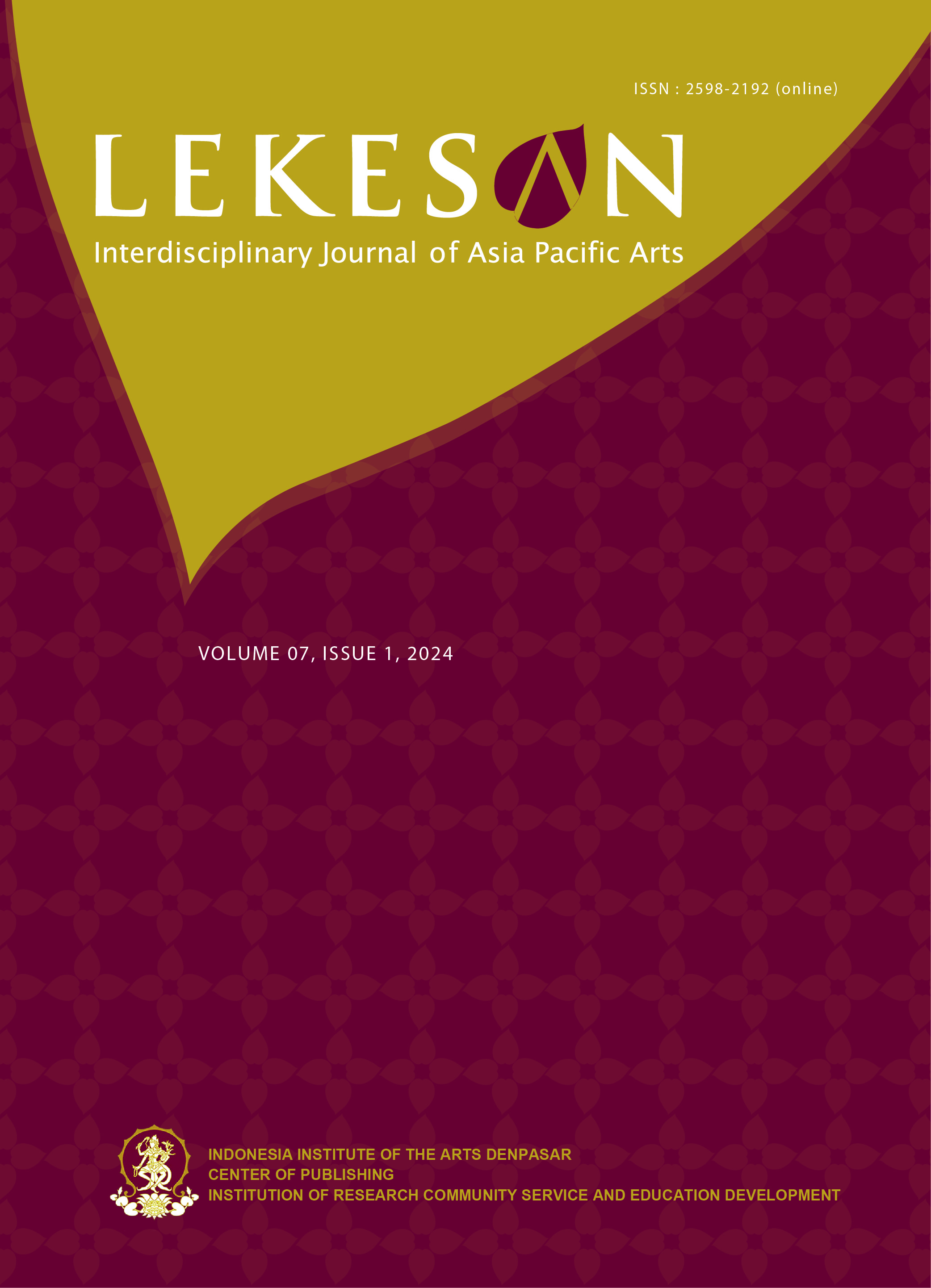TETIKESAN PRACTICAL TRAINING OF WAYANG PARWA BEBADUNGAN STYLE PERFORMANCE IN SANGGAR MAJALANGU
DOI:
https://doi.org/10.31091/lksn.v7i1.2805Abstract
Abstract
Wayang Parwa performances in the last three decades have become increasingly rare in society. This performance originates from the Mahabharata epic and is accompanied by the Gender Wayang gamelan, which is one of the oldest in Bali. Wayang Parwa is usually used as a basis for learning to become a puppeteer in formal and non-formal education. Wayang Parwa has many versions, and in Bali, there are four styles of Wayang Parwa: Bebadungan Style, Sukawati Style, Tunjung Style, and Buleleng (North Bali). One of the styles with the most favorite is the Bebadungan style, which is spread across six districts/cities in Bali, such as Tabanan, Negara, Klungkung, Bangli, Karangasem, and Denpasar City. With the emergence of various variants of innovative wayang performances, the popularity of Wayang Parwa has decreased.
To maintain the existence of the Wayang Parwa Bebadungan Style performance in this millennial era, conservative efforts needed to be made, namely through training. Considering the Wayang Parwa Bebadungan style performances by today's young puppeteers, many need to be stronger in Tetikesan (puppet movements). For this reason, the training material provided to members of Sanggar Majalangu, Kerobokan Village, North Kuta District, Badung Regency, led by I Made Agus Adi Santika, is Tetikesan. This training could answer the public's opinion that the weakness of the Wayang Parwa Bebadungan style performance refers to Tetikesan. The training was focused on one of the studio members using instructional, structured, gradual, and innovative learning methods by utilizing YouTube media, which releases audio recordings of Wayang Buduk performances by puppeteer Ida Bagus Arnawa (deceased) and his son, puppeteer Ida Bagus Puja (deceased) as standardization of the Bebadungan style.
Keywords: Training, Tetikesan, Wayang Parwa Bebadungan Style
Downloads
References
Bandem, I. M. (1983). Gerak Tari Bali Laporan Penelitian (Denpasar). Akademi Seni Tari Indonesia.
Marajaya, I. M. (1994). Tetikesan Sebagai Ragam Gerak dalam Pertunjukan Wayang Kulit Bali. STSI Denpasar.
Marajaya, I. M. (2008). Gaya Pedalangan Jawa dan Bali. Wayang (Jurnal Ilmiah Seni Pewayangan), 7(1).
Mardiwarsito, L. (2001). Kamus bahasa Indonesia-Jawa Kuno. Balai Pustaka.
Mudhoffir. (1999). Teknologi Instruksional (Bandung). Remaja Rosdakarya.
Panitia Penyusun Kamus Bali-Indonesia. (1978). Kamus Bali-Indonesia. Dinas Pengajaran, Propinsi Daerah Tingkat I Bali.
Poerwadarminta, W. J. S. (2003). Kamus umum Bahasa Indonesia. Balai Pustaka.
Sedana, I. N. (1986). Wayang Arja Di Dusun Bona Kelod Gianyar (ASTI Denpasar). FSP pedalangan.
Seramasara, I. G. N. (2006). WAYANG KULIT BALI DIANTARA TRADISI DAN PERUBAHAN: SEBUAH DILEMA DAN HARAPAN DALAM PELESTARIAN SENI BUDAYA BALI. Mudra (JURNAL SENI BUDAYA), 19(2).
Seramasara, I. G. N. (2007). Seni Pertunjukan Tradisional Bali, Sebuah Renungan Sejarah. Mudra Jurnal Seni Budaya, 20(1).
Soedarsono. (1978). Pengantar Pengetahuan dan Komposisi Tari. Akademi Seni Tari Indonesia.
Sugriwa, I. G. B. (1985). Ilmu Pedalangan/Pewayangan. Yayasan Pewayangan Daerah Bali.
Wicaksana, I. D. K. (2007). Gaya Pedalangan/Pewayangan Berbagai Daerah di Indonesia. Wayang (Jurnal Ilmiah Seni Pewayangan), 7(1).
Widnyana, I. K. (2005). PENITITALA DAN APRESIASI DALAM MENINGKATKAN KREATIVITAS SENIMAN DALANG. Wayang (JURNAL ILMIAH SENI PEWAYANGAN), 4(1).
Yudabakti, I. M. (2013). Marginalisasi Pertunjukan Wayang Kulit Parwa di Kota Gianyar [Disertasi Program Doktor]. Universitas Udayana.
Downloads
Published
How to Cite
Issue
Section
License
Copyright (c) 2024 I Made Marajaya, Ni Komang Sekar Marhaeni, I Kt. Suteja

This work is licensed under a Creative Commons Attribution-NonCommercial-ShareAlike 4.0 International License.






